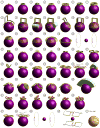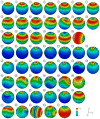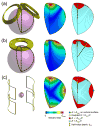Electric field depth-focality tradeoff in transcranial magnetic stimulation: simulation comparison of 50 coil designs
- PMID: 22483681
- PMCID: PMC3568257
- DOI: 10.1016/j.brs.2012.02.005
Electric field depth-focality tradeoff in transcranial magnetic stimulation: simulation comparison of 50 coil designs
Abstract
Background: Various transcranial magnetic stimulation (TMS) coil designs are available or have been proposed. However, key coil characteristics such as electric field focality and attenuation in depth have not been adequately compared. Knowledge of the coil focality and depth characteristics can help TMS researchers and clinicians with coil selection and interpretation of TMS studies.
Objective: To quantify the electric field focality and depth of penetration of various TMS coils.
Methods: The electric field distributions induced by 50 TMS coils were simulated in a spherical human head model using the finite element method. For each coil design, we quantified the electric field penetration by the half-value depth, d(1/2), and focality by the tangential spread, S(1/2), defined as the half-value volume (V(1/2)) divided by the half-value depth, S(1/2) = V(1/2)/d(1/2).
Results: The 50 TMS coils exhibit a wide range of electric field focality and depth, but all followed a depth-focality tradeoff: coils with larger half-value depth cannot be as focal as more superficial coils. The ranges of achievable d(1/2) are similar between coils producing circular and figure-8 electric field patterns, ranging 1.0-3.5 cm and 0.9-3.4 cm, respectively. However, figure-8 field coils are more focal, having S(1/2) as low as 5 cm(2) compared to 34 cm(2) for circular field coils.
Conclusions: For any coil design, the ability to directly stimulate deeper brain structures is obtained at the expense of inducing wider electrical field spread. Novel coil designs should be benchmarked against comparison coils with consistent metrics such as d(1/2) and S(1/2).
Copyright © 2013 Elsevier Inc. All rights reserved.
Figures





Comment in
-
How far can TMS coils be optimized? A partial resolution.Brain Stimul. 2013 Jan;6(1):15. doi: 10.1016/j.brs.2012.02.002. Epub 2012 Mar 13. Brain Stimul. 2013. PMID: 22445535 No abstract available.
-
Commentary on: Deng et al., Electric field depth-focality tradeoff in transcranial magnetic stimulation: simulation comparison of 50 coil designs.Brain Stimul. 2013 Jan;6(1):14-5. doi: 10.1016/j.brs.2012.04.003. Epub 2012 Apr 23. Brain Stimul. 2013. PMID: 22560047 No abstract available.
References
-
- Fitzgerald PB, Daskalakis ZJ. The effects of repetitive transcranial magnetic stimulation in the treatment of depression. Expert Rev Med Devices. 2011;8:85–95. - PubMed
-
- Fitzgerald PB, Fountain S, Daskalakis ZJ. A comprehensive review of the effects of rTMS on motor cortical excitability and inhibition. Clin Neurophysiol. 2006;117:2584–2596. - PubMed
-
- Deng Z-D, Peterchev AV, Lisanby SH. Coil design considerations for deep-brain transcranial magnetic stimulation (dTMS). Conf Proc IEEE Eng Med Biol Soc; 2008. pp. 5675–5679. - PubMed
-
- Krings T, Buchbinder BR, Butler WE, Chiappa KH, Jiang HJ, Rosen BR, et al. Stereotactic transcranial magnetic stimulation: correlation with direct electrical cortical stimulation. Neurosurgery. 1997;41:1319–1325. - PubMed
-
- Tofts PS. The distribution of induced currents in magnetic stimulation of the nervous system. Phys Med Biol. 1990;35:1119–1128. - PubMed
Publication types
MeSH terms
Grants and funding
LinkOut - more resources
Full Text Sources
Other Literature Sources

